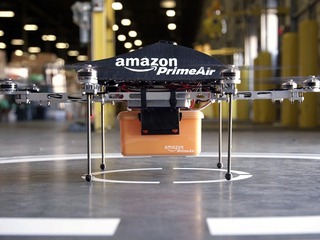M&A activity in the warehouse robotic space
Robots are taking over the heavy lifting work inside warehouses
Read more...
(Come mingle with hundreds of top venture capitalists representing $10B-plus in capital under management, including Khosla Ventures, Greylock and Javelin Venture Partners, and learn from founders/CEOs including Marco Zappacosta, Co-founder & CEO of Thumbtack and Adam Goldenberg, CEO of JustFab, Slava Rubin, Founder & CEO of Indiegogo, at Vator Splash Oakland on April 22nd and 23rd. Get your tickets here!)
Amazon has been in a battle with the Federal Aviation Administration over drones for almost two years now. On the one side, Amazon wants to test out drones so they can deliver packages, while the FAA talks about safety and
There seemed to finally be what looked like the beginning of a coming together last week, when the FAA announced that it was now going to allow Amazon to test out drone delivery. Sure there were provisions, but it was a start, right?
Not really, according to testimony from Paul Misener, Vice President for Global Public Policy at Amazon, in front of a Senate Subcommittee on Aviation Operations, Safety and Security on Tuesday. In fact, the "experimental airworthiness certificate," it was awarded is too little, too late.
While noting that Amazon is "very grateful to the FAA for granting us permission to conduct UAS testing outdoors in the United States," Misener said that "while the FAA was considering our applications for testing, we innovated so rapidly that the UAS approved last week by the FAA has become obsolete."
"We don’t test it anymore. We’ve moved on to more advanced designs that we already are testing abroad."
In fact, on Friday, the day after the FAA gave Amazon permission to test outside, the company then "asked the FAA for permission to fly one of these advanced UAS in the United States, as well." It still has not been granted permission.
Misener was highly critical of the regulatory process in the United States, as compared to the rest of the world. In fact, nowhere outside the U.S. has Amazon had to wait any more then two months before it could be begin testing, as opposed to a year and a half in the U.S.
"Our testing abroad has required but minimal aviation regulatory approval, given the low risk presented by our small UAS designs; the R&D nature of our flight activity; and our relatively rural test sites," said Misener.
"Nowhere outside of the United States have we been required to wait more than one or two months to begin testing, and permission has been granted for operating a category of UAS, giving us room to experiment and rapidly perfect designs without being required to continually obtain new approvals for specific UAS vehicles."
In addition, Misener also expressed his unhappiness with new guidelines on operating drones releasedearlier this year, which pretty much banned any kind of commercial usage. They include restricting drones to daylight hours, making it so the operator of the drone has to be able to see the it while it is flying, and now allowing them to fly over people "not directly involved in the operation."
While the FAA is concerned about collisions and crashes, the technology has advanced to the point, he said, where "automated UAS sense and avoid technology and on-board intelligence address these factors and will mitigate the related risks."
Ultimately, Misener warned that the U.S. could fall behind given how long Amazon has been fighting for the approval it did get, which is now not even of any use. Groups that are supposed to be meeting regarding drone safety, but have only met two times since last year.
"This low level of government attention and slow pace are inadequate, especially compared to the regulatory efforts in other countries," he told the Senate subcommittee.
"This is not to suggest that regulators here or abroad can quickly adopt actual rules for UAS operations beyond visual line of sight. That may take some time. But surely regulators should start proposing regulatory frameworks and rules for future commercial UAS operations now."
Amazon drones
Amazon announced all the way back in 2013 that it wanted to start delivering packages via drone. The Federal Aviation Administration expressly forbade the practice, though, stating that any unmanned aerial vehicle not used for hobby or recreation, i.e. a commercial business like Amazon’s, was to remain illegal in the United States.
There is also a lot of money at stake. Funding for startups in the drone space more than doubled in 2014 growing by 104%. Overall, $108 million was invested in a total of 29 deals during the year. The number of deals has jumped very quickly in just the last couple of years; a total of just five deals were done in the years spanning 2010 to 2012 combined, while 11 were completed in the third quarter of 2014 alone.
Even more money was spent on lobbying efforts for the industry; $186 million in total, up from only $35 million in 2011.
(Image source: news.cs.washington.edu)
Robots are taking over the heavy lifting work inside warehouses
Read more...The company also expanded access to 12 different provider types for male fertility care
Read more...Ezra's AI cancer screening platform will be available in 150 RAYUS locations
Read more...